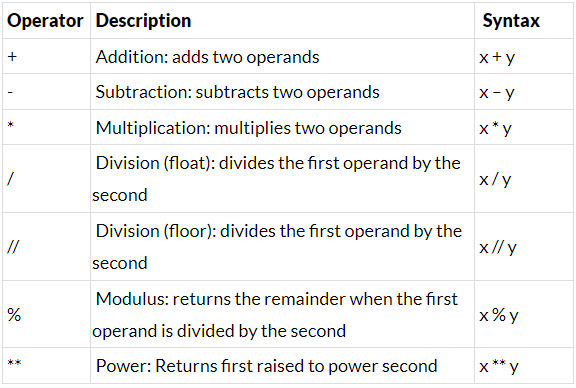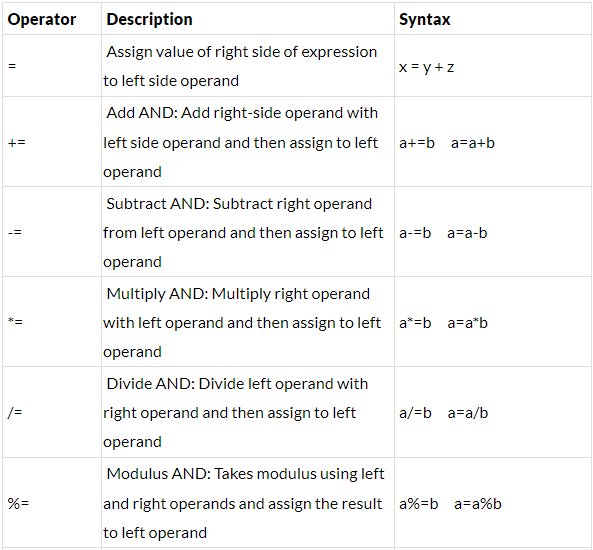Python Operators - Class 9 PDF Download
Python Operators in general are used to perform operations on values and variables. These are standard symbols used for the purpose of logical and arithmetic operations. In this article, we will look into different types of Python operators.
Arithmetic Operators
Arithmetic operators are used to performing mathematical operations like addition, subtraction, multiplication, and division.

Example: Arithmetic operators in Python
Python3
# Examples of Arithmetic Operator
a = 9
b = 4
# Addition of numbers
add = a + b
# Subtraction of numbers
sub = a - b
# Multiplication of number
mul = a * b
# Division(float) of number
div1 = a / b
# Division(floor) of number
div2 = a // b
# Modulo of both number
mod = a % b
# Power
p = a ** b
# print results
print(add)
print(sub)
print(mul)
print(div1)
print(div2)
print(mod)
print(p)
Output
13
5
36
2.25
2
1
6561
Comparison Operators
Comparison of Relational operators compares the values. It either returns True or False according to the condition.

Example: Comparison Operators in Python
Python3
# Examples of Relational Operators
a = 13
b = 33
# a > b is False
print(a > b)
# a < b is True
print(a < b)
# a == b is False
print(a == b)
# a != b is True
print(a != b)
# a >= b is False
print(a >= b)
# a <= b is True
print(a <= b)
Output
False
True
False
True
False
True
Logical Operators
Logical operators perform Logical AND, Logical OR, and Logical NOT operations. It is used to combine conditional statements.

Example: Logical Operators in Python
Python3
# Examples of Logical Operator
a = True
b = False
# Print a and b is False
print(a and b)
# Print a or b is True
print(a or b)
# Print not a is False
print(not a)
Output
False
True
False
Bitwise Operators
Bitwise operators act on bits and perform the bit-by-bit operations. These are used to operate on binary numbers.

Example: Bitwise Operators in Python
Python3
# Examples of Bitwise operators
a = 10
b = 4
# Print bitwise AND operation
print(a & b)
# Print bitwise OR operation
print(a | b)
# Print bitwise NOT operation
print(~a)
# print bitwise XOR operation
print(a ^ b)
# print bitwise right shift operation
print(a >> 2)
# print bitwise left shift operation
print(a << 2)
Output
0
14
-11
14
2
40
Assignment Operators
Assignment operators are used to assigning values to the variables.


Example: Assignment Operators in Python
Python3
# Examples of Assignment Operators
a = 10
# Assign value
b = a
print(b)
# Add and assign value
b += a
print(b)
# Subtract and assign value
b -= a
print(b)
# multiply and assign
b *= a
print(b)
# bitwise lishift operator
b <<= a
print(b)
Output
10
20
10
100
102400
Identity Operators
is and is not are the identity operators both are used to check if two values are located on the same part of the memory. Two variables that are equal do not imply that they are identical.
is True if the operands are identical
is not True if the operands are not identical
Example: Identity Operator
Python3
a = 10
b = 20
c = a
print(a is not b)
print(a is c)
Output
True
True
Membership Operators
in and not in are the membership operators; used to test whether a value or variable is in a sequence.
in True if value is found in the sequence
not in True if value is not found in the sequence
Example: Membership Operator
Python3
# Python program to illustrate
# not 'in' operator
x = 24
y = 20
list = [10, 20, 30, 40, 50]
if (x not in list):
print("x is NOT present in given list")
else:
print("x is present in given list")
if (y in list):
print("y is present in given list")
else:
print("y is NOT present in given list")
Output
x is NOT present in given list
y is present in given list
Precedence and Associativity of Operators
Precedence and Associativity of Operators: Operator precedence and associativity determine the priorities of the operator.
Operator Precedence
This is used in an expression with more than one operator with different precedence to determine which operation to perform first.
Example: Operator Precedence
Python3
# Examples of Operator Precedence
# Precedence of '+' & '*'
expr = 10 + 20 * 30
print(expr)
# Precedence of 'or' & 'and'
name = "Alex"
age = 0
if name == "Alex" or name == "John" and age >= 2:
print("Hello! Welcome.")
else:
print("Good Bye!!")
Output
610
Hello! Welcome.
Operator Associativity
If an expression contains two or more operators with the same precedence then Operator Associativity is used to determine. It can either be Left to Right or from Right to Left.
Example: Operator Associativity
Python3
# Examples of Operator Associativity
# Left-right associativity
# 100 / 10 * 10 is calculated as
# (100 / 10) * 10 and not
# as 100 / (10 * 10)
print(100 / 10 * 10)
# Left-right associativity
# 5 - 2 + 3 is calculated as
# (5 - 2) + 3 and not
# as 5 - (2 + 3)
print(5 - 2 + 3)
# left-right associativity
print(5 - (2 + 3))
# right-left associativity
# 2 ** 3 ** 2 is calculated as
# 2 ** (3 ** 2) and not
# as (2 ** 3) ** 2
print(2 ** 3 ** 2)
Output
100.0
6
0
512


















